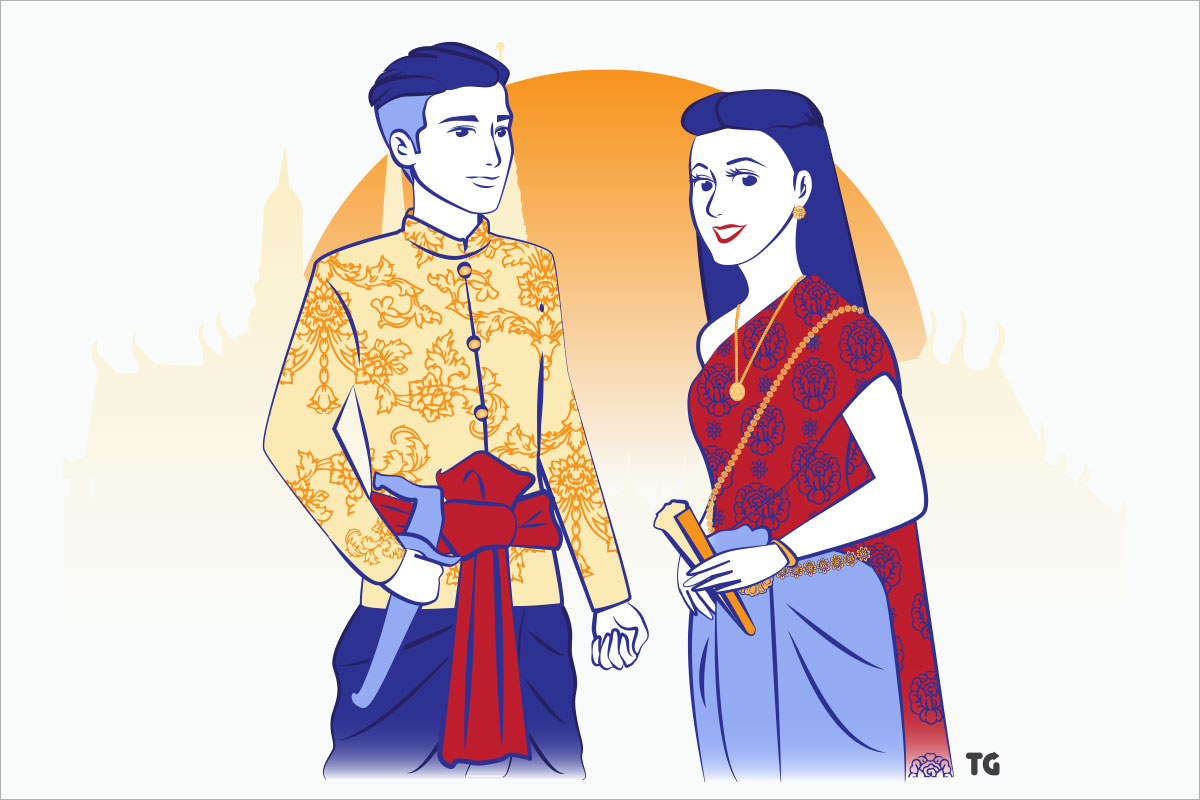Are you a fan of Thai dramas? Or perhaps you follow Lisa, the world-famous Thai K-pop idol, and her music videos? If yes, you’ve surely noticed the beautiful, traditional Thai dresses that are being worn.
But what exactly are those outfits called? And where can you find one for yourself?
Well, this article is here to tell you everything you need to know about Thai traditional dresses – from their history, componentry, and the different types for various occasions. You’ll also find out about traditional Thai men’s clothing, as well as places where couples can go buy (or rent) traditional Thai outfits.
Let’s start with the origins of Thai clothing.
History of clothing in Thailand
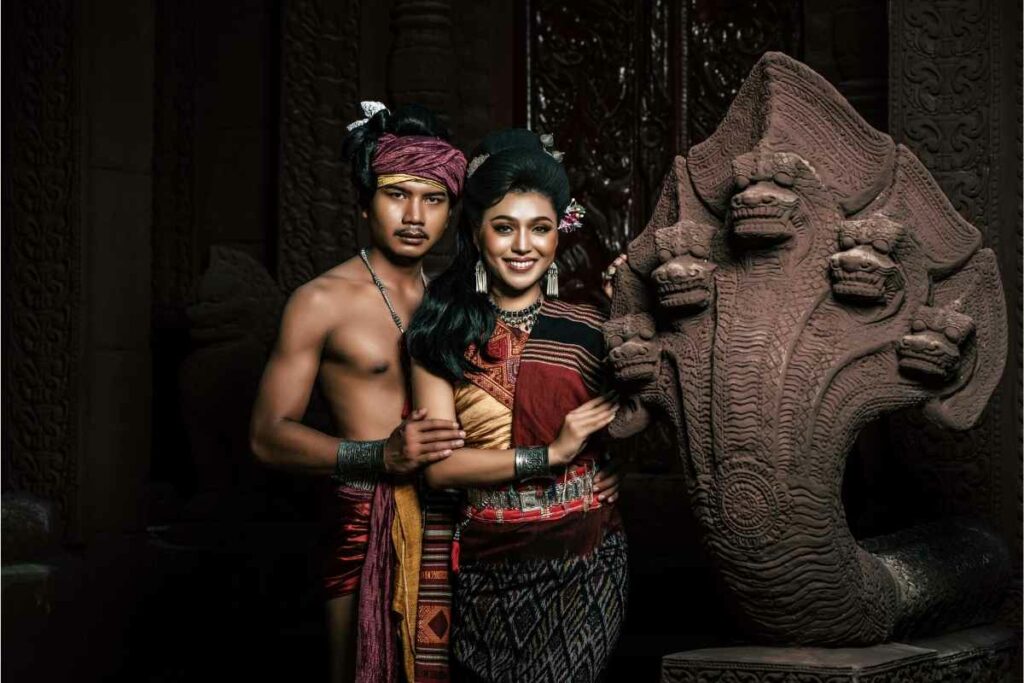
Unlike in some cultures, there is no one specific clothing “style” when it comes to the way Thailand traditionally dressed. Traditional attire and dresses vary depending on the era and region of Thailand – making them as diverse as they come.
As you would expect, the history of Thai clothing dates back to the country’s ancient kingdoms. Here’s a summary of how clothing styles have evolved through the eras and why:
Early Indian and Khmer (Cambodian) influence
During the era of the Dvaravati Kingdom (6th-13th Century), the outfit styles were influenced by India –such as golden necklaces, metal belts, and loincloths. During the Lavo Kingdom in the 7th Century, the dress styles were influenced by the Khmer (early Cambodia), and shorter dresses became the norm. (Source)
Wrapped clothing
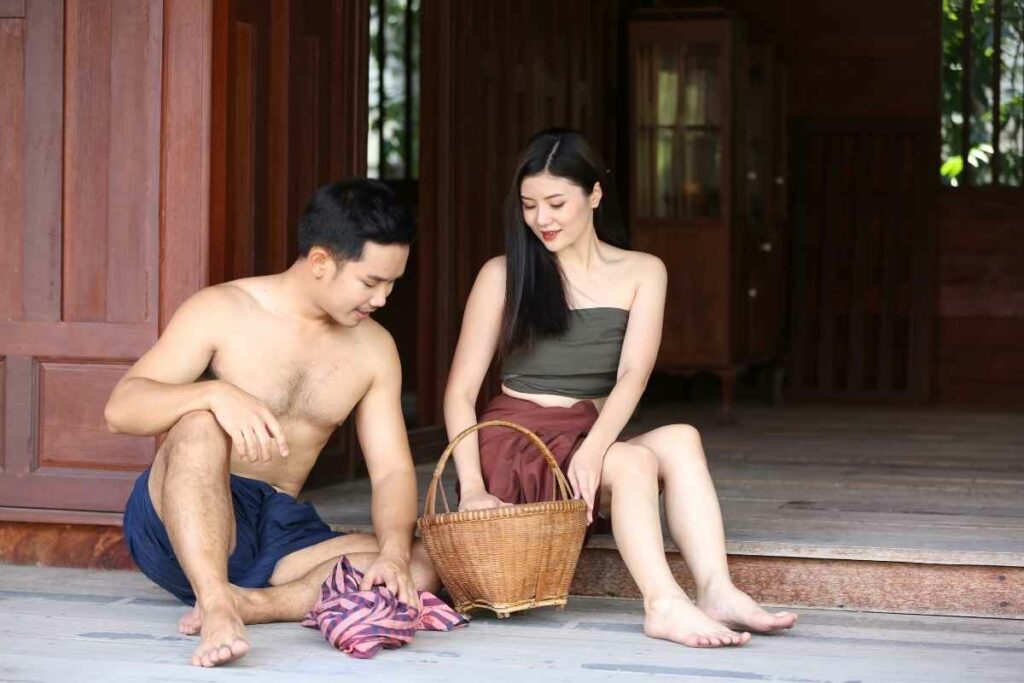
Pha Chung Hang:
According to history, both Thai men and women used to dress in a loincloth wrap – known as Pha Chung Hang. Males would wear their Pha Chung Hang to cover from the waist to halfway down their thighs. As for women, they would wear Pha Chung Hang down their waists to well below the knees.
Royal family members wore silk robes that were called Khuri and a tall, pointed hat known as Lomphok when attending royal affairs. As seen in murals, early photographs, and illustrations from up to the middle-1800s, bare feet and bare chests were accepted as part of the informal Thai dress code.
Pha Nung:
The main components of a traditional Thai outfit during the reign of King Rama IV had primarily made up of Pha Nung and Pha Hom garments – one cloth to cover the lower body and another cloth to cover the upper body for both men and women.
Before the 20th century, the primary factor that differentiated the class of clothing in Thailand was the use of silk and cotton cloths with printed or woven motifs. Both commoners and royals alike would wear wrapped clothing – not stitched ones.
Traditional Thai outfits changed significantly during the Rattanakosin era.
Stitched clothing
Victorian fashion:
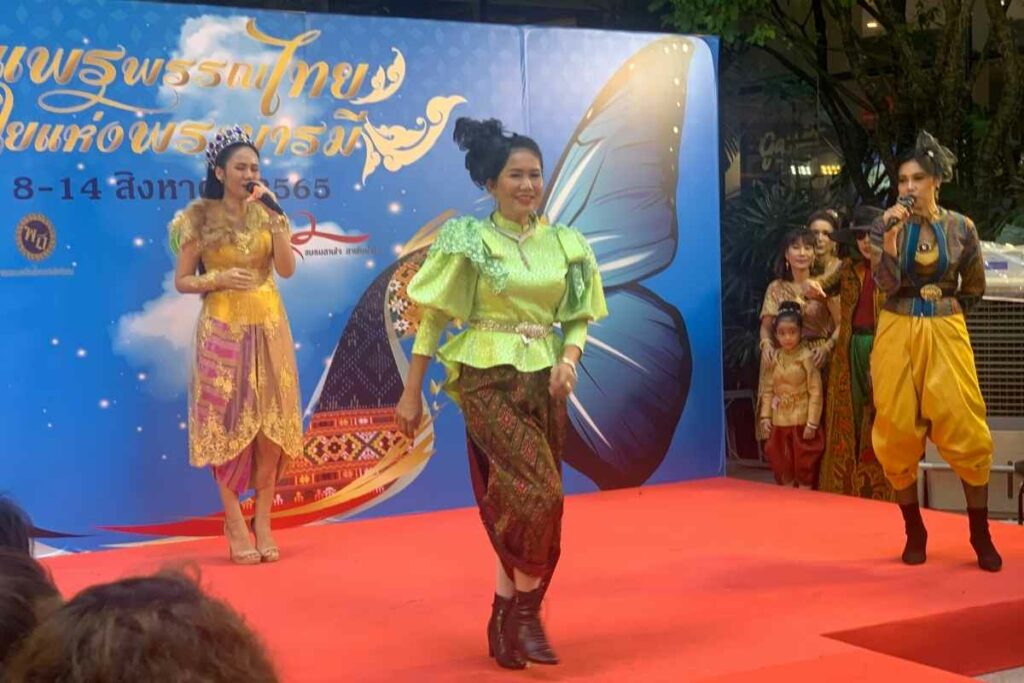
Since the 1860s, Thai royals have selectively adopted Victorian fashion and etiquette to Thai fashion.
During the reign of King Chulalongkorn (King Rama V), stitched clothing, including ceremonial uniforms and court attires, was created.
Western-style dresses became popular among the city people in Bangkok during this era. Women began to wear Victorian-style shirts with high collars, puffy sleeves, and lace. Many women would mix their Thai clothing items with Western garment pieces. It was typical to see Victorian shirts adorned with a Sabai and worn with Jong Kraben.
Raj pattern:
Men’s fashion in Thailand also evolved, and Raj pattern-style jackets began to replace cotton shirts or silk shirts, which were popularized during King Rama IV’s reign. Both women and men during that era would wear their Jong Kraben outfits with knee-high socks and leather shoes to appear more Westernized.
Westernization:
On January 15th, 1941, Plaek Pibulsonggram (Prime Minister of Thailand 1948 – 1957) issued a Thai cultural mandate to modernize and Westernize Thai outfits. He deemed the long-practiced tradition of wearing underpants, not wearing any shirt, or wearing a wraparound cloth to be forms of inappropriate public attire. (Source, Source)
How was Chut Thai clothing created?
When H.M. King Bhumibol ascended to the throne in 1950, the way Thai dressed peopled dressed had already been influenced by Western styles.
With his wife, H.M. Queen Sirikit, the King prioritized reforming and changing the institute in a way that would enhance and solidify the identity of Thai nationality.
As a part of this institutional reform plan, Queen Sirikit established a national Thai costume – which would later be known as “Chut Thai” or Chut Thai Phra Ratcha Niyom.
Chut Thai clothing was created because for the Thai people, having an official national costume helps to unify the country’s identity. Additionally, every style of Chut Thai shows different traditional weaving techniques, local patterns, the inherent modesty of the local people, and the imagery from the country.
To craft outfits that would be recognized as traditional Thai clothing, the Queen worked with French designers. Taking inspiration from historical photographs, writings, and the remaining royal garments and fabrics.
As the historic brocades preserved in Royal Treasury were too fragile to be worn, the new ones were woven to create traditional dresses for the Queen. The Queen and the designers then came up with eight different looks for Thai women and an essential one for men. (Source)
Components of Chut Thai
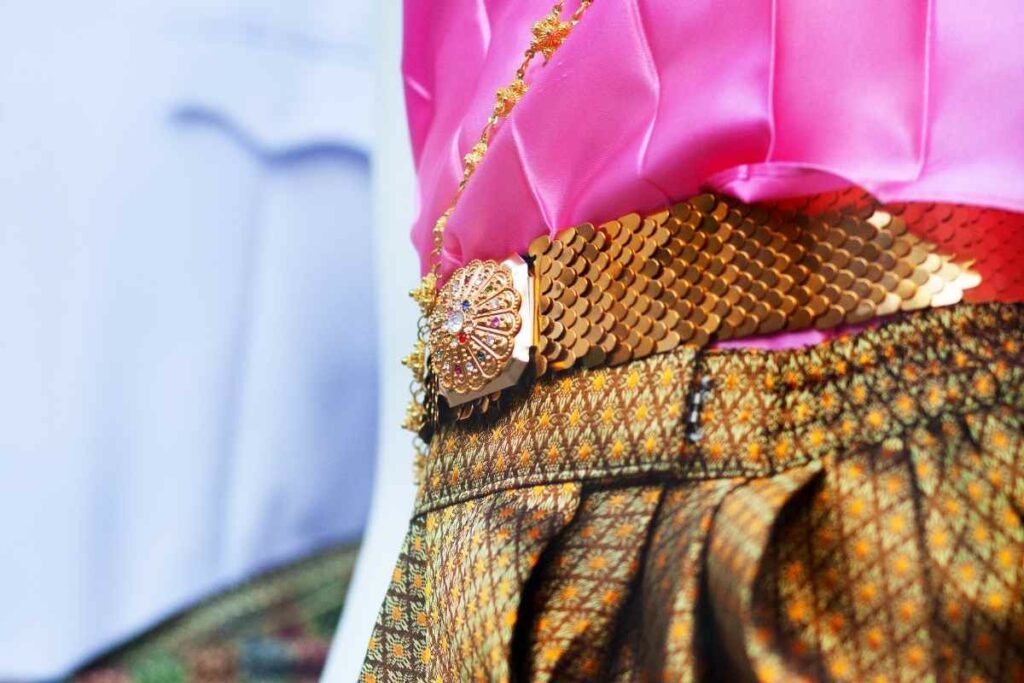
Chut Thai is usually known for its modest yet bright look. The outfits are generally made of silk (as Thailand is known for the quality of this fabric).
Since India and Cambodia had influenced the fashion designs of Thailand, the current designs still exhibit the use of gold and silver, which were first popularized in Thailand by these countries.
There are also essential components in almost every Chut Thai clothing. Below are their terms and how to wear each of them:
Pha Sinh
Pha Sinh (ผ้าซิ่น) is the base component of all the variations of women’s traditional Thailand dresses. It is also known as a Pha Nung or a Pha Thung.
Pha Sinh is a tube of fabric or silk for more formal occasions and worn as a skirt. The fabric is folded and tucked by the wearer to make the skirt tight around the waist and form a fold in the front.
When worn correctly, the fabric in the fold would be even with the rest of the fabric. Therefore, one can quickly check if they have worn it the right way or not.
Pha Sinh is not only worn during formal occasions. It is very common to see women, particularly elderly women in the villages, wearing a Pha Sinh with an informal top. They are also commonly used for going between shower and bedroom, especially in the countryside as one can change underneath.
And although Pha Sinh is usually made of silk when worn on formal occasions, it is easy to buy cheaper cotton-made versions of Pha Sinh at the local markets in Thailand. (Source, Source)
Pha Chung Hang (or Chang Kben)
A Pha Chung Hang, also known as Chang Kben, is a long rectangular piece of wraparound cloth for the lower body and can be worn by both men and women.
Pha Chung Hang is synonymous with the Khmer Sampot as well. It resembles pants more than it is a skirt. It is worn by wrapping the Pha Chung Hang around the waist, stretching the cloth away from the body, twisting the ends together, and pulling the twisted part between the legs to tuck it in the back of the waist.
Pha Biang (or Sabai)
Pha Biang (ผ้าเบี่ยง) or Sabai (สไบ) is a shawl-like cloth or “breast cloth” and also can be used by either women or men.
It is a long clothing piece made of silk and about a foot wide. The wearer must drape the Sabai or Pha Biang diagonally around the chest by covering one shoulder while its end falls behind the back. Pha Biang could be worn on top of another cloth or around the naked chest.
During the reign of King Chulalongkorn, it was a common practice to wear Pha Biang together with Victorian-era outfits. This practice lasted until King Vajiravudh, when Westernized dresses became more fashionable.
During the 1940’s Thai clothing reform, the wearing of Pha Biang, a daily outfit, was officially banned by Plaek Pibulsonggram.
Raj pattern costumes
Raj pattern means either a Thai male costume (ชุดราชปะแตน) which consists of a white Nehru-style jacket with five buttons, a Pha Chung Hang, knee-length socks, and dress shoes, or the specific form of the jacket itself (ราชปะแตน).
Raj pattern clothes were worn mainly by government officials and the upper-class elites of Bangkok during the late 19th Century and early 20th Century. These days, it is used on particular occasions as a Thai national costume for men. (Source)
8 Types of formal Chut Thai
Formal Chut Thai dress for women
As mentioned above, there are eight different designs for women’s formal Chut Thai outfits. Different designs of Chut Thai outfits are used for different occasions – both formal and informal.
1. Thai Chakkri
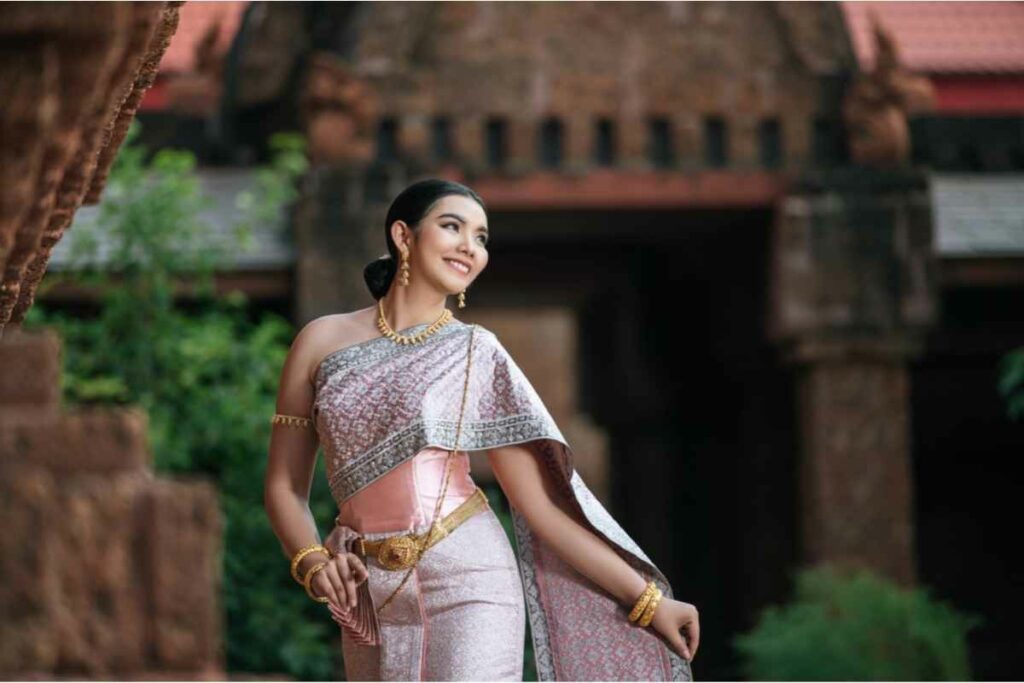
Chakkri is one of the most famous traditional Thai dresses. It is commonly worn as a formal dress to the point that when people say ‘Thai traditional costume,’ it is very likely that most people would think of Chakkri.
Chakkri dresses are considered to be formal and elegant. It is made up of Pha Sinh, which in this case is typically a Yok Dork brocade and may even have gold and silver threads weaved into the cloth. The top is usually made from silk, and a Sabai is wrapped over the shoulder to complete the look.
Women would wear a gold or silver belt over the Pha Sinh, and other gold and silver Thai jewelry would be worn as accessories while wearing a Chakkri.
2. Thai Chakkraphat
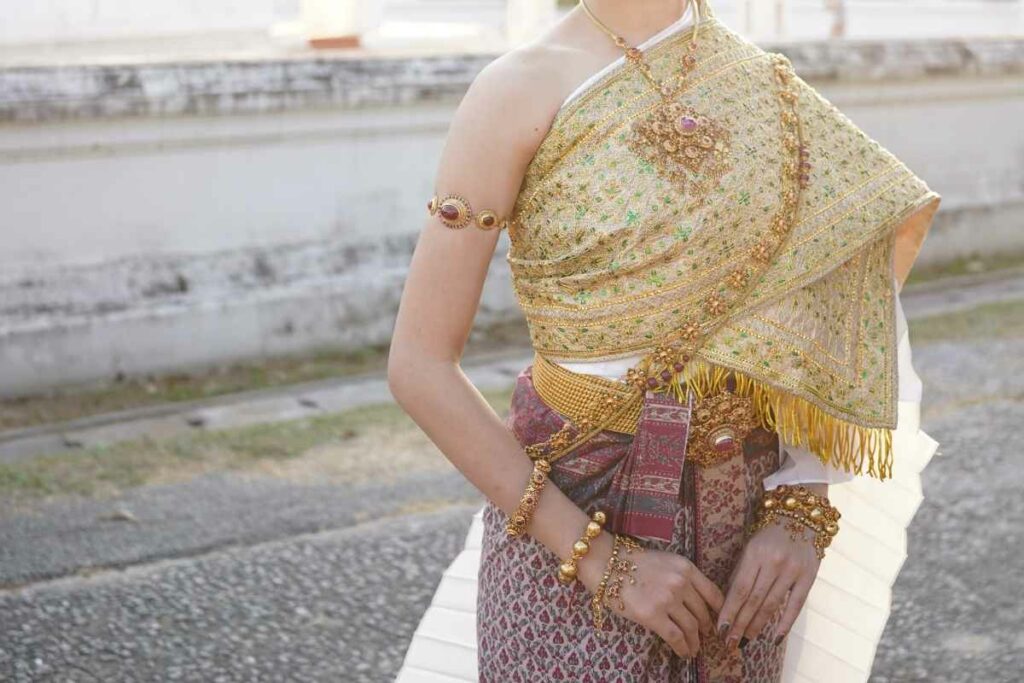
Chakkraphat is another formal outfit worn for royal ceremonies. It is similar to Chakkri but has a more conservative design and is considered more official.
The Chakkraphat used two Sabai shawls – one is a pleated shawl cover, and another one is a thicker shawl with a lot of detailed embroideries.
This combination is considered to be one of the most formal and elegant types of Chut Thai dresses for Thai women. Since the name of the dress itself means “Emperor”, this outfit is usually reserved for royal and national ceremonies.
3. Thai Amarin
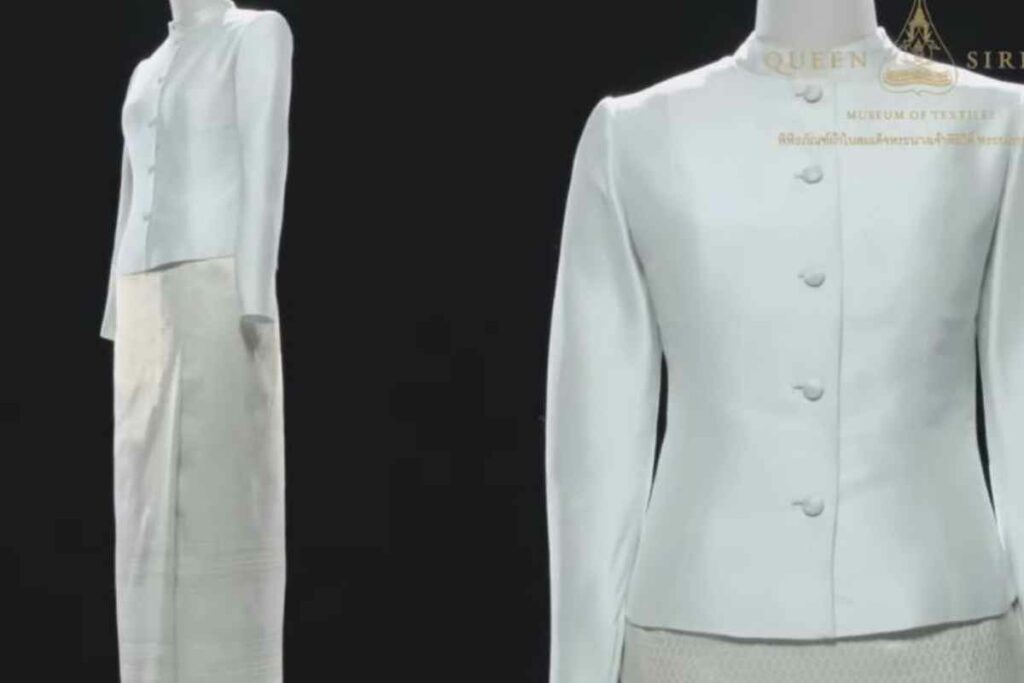
An Amarin is often worn by the royals and is considered a luxurious evening dress. It is usually worn during royal ceremonies with all the requisite royal ornaments.
The dress consists of a brocade Pha Sinh and a broad, almost square-like blouse. The blouse may have a wide, rounded neckline with sleeves extending to just below the elbow and buttons all the way up to the throat’s front.
Typically, the blouse in the Amarin dress is not tucked in, and there is no need to wear a belt either.
4. Thai Boromphiman
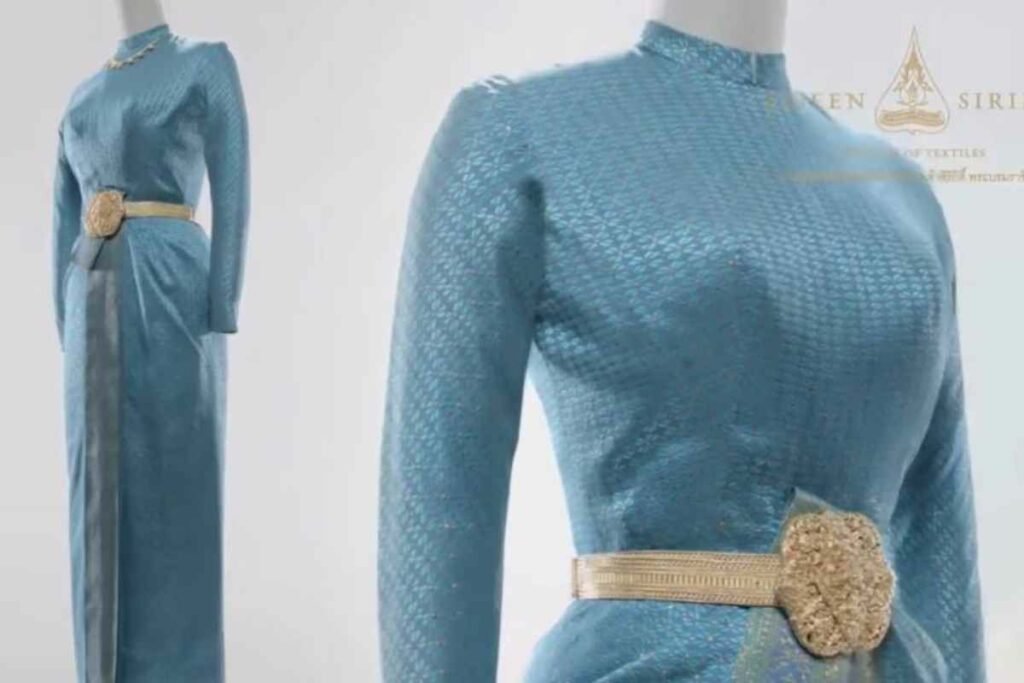
This is another formal dress used as an evening attire.
Boromphiman consists of an ankle-length Pha Sinh tube skirt and a long-sleeved blouse with a round neck as the top. The buttons of the blouse can be found either on the front or back. Sometimes, the skirt and the blouse of Boromphiman are sewn together to form a dress.
The outfit is made from fine fabric, giving it a luxurious and elegant look. There is no Sabai in Boromphiman. The outfit is usually completed with a silver or golden belt and gold or silver jewelry as accessories.
Boromphiman dresses can be worn for formal and semi-formal occasions.
5. Thai Siwalai
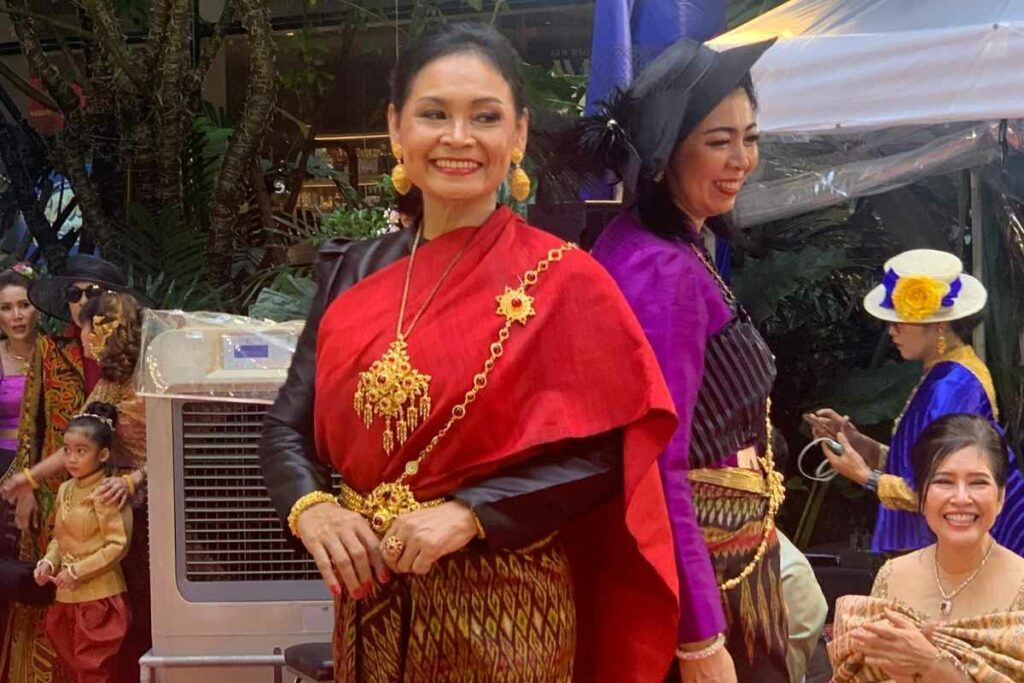
Siwalai is another formal evening dress and is almost identical to a Boromphiman, apart from there is a Sabai in the Siwalai dress.
Siwalai is like a combination of the two previous dress styles, as it incorporates a Sabai and a long-sleeved top. And most of the time, this outfit is mainly worn during royal ceremonies, formal functions, and other official events.
6. Thai Ruean Ton
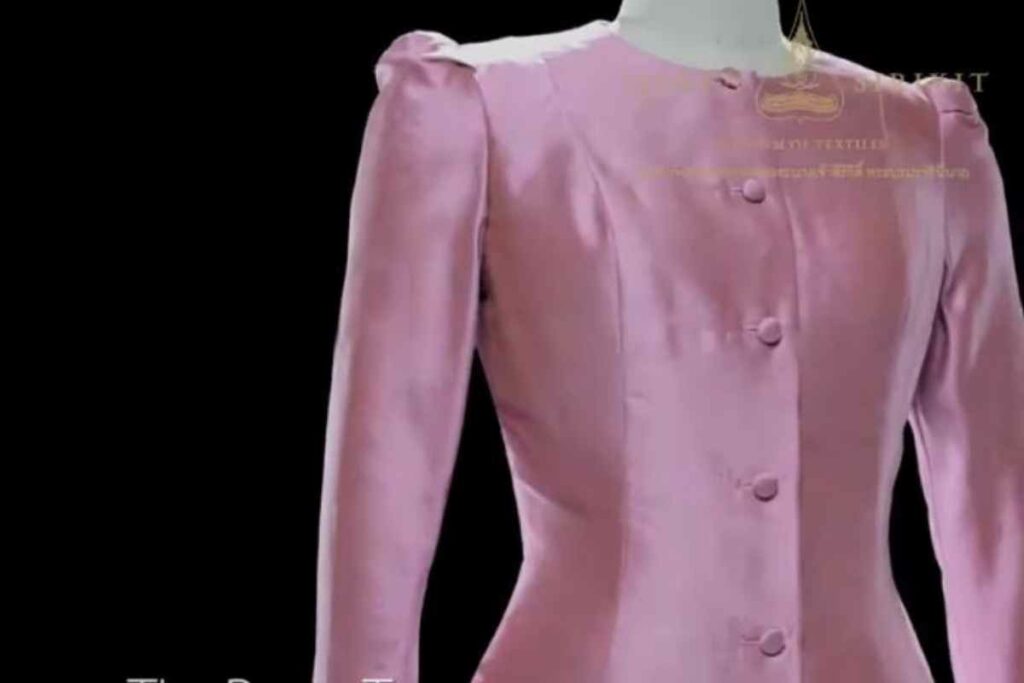
This is the most casual female outfit out of all eight Chut Thai dresses for women.
Ruean Ton is usually worn during non-official functions where a smart casual dress code is needed. The Ruean Ton consists of a Pha Sinh that is usually plain-colored, with horizontal or vertical stripes, and a long-sleeved, collarless blouse. The blouse has a row of buttons at the front and elbow-length sleeves and is typically tucked in. The outfit is usually completed with a belt.
7. Thai Chitlada
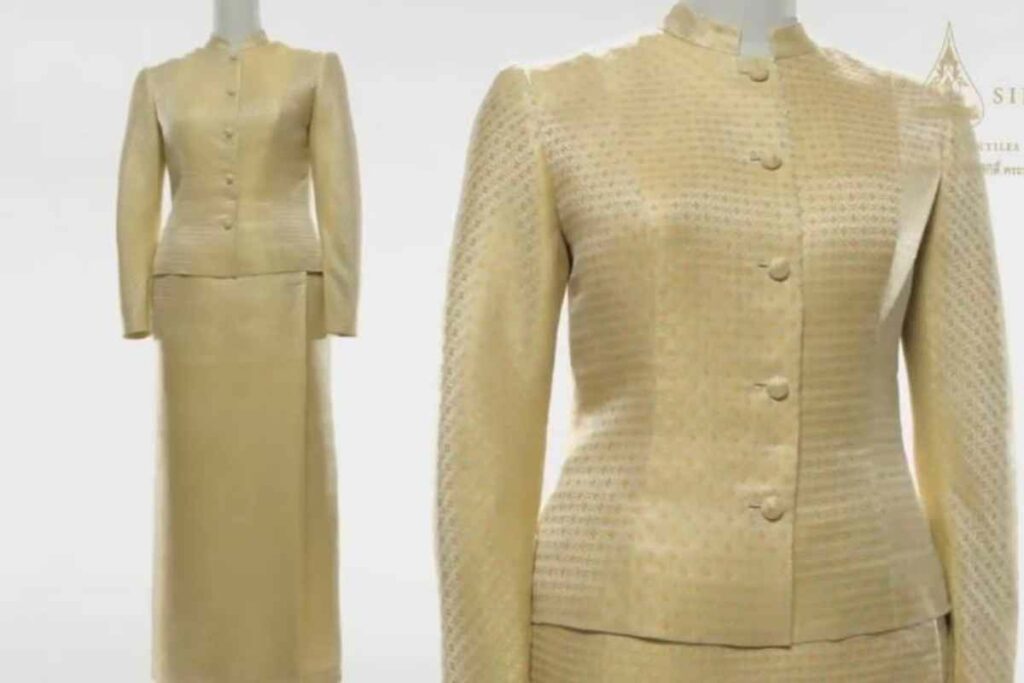
For daytime events, a Chitlada is worn as a formal ceremonial outfit and is usually worn by Thai officials.
They are generally worn to greet official royal guests. The outfit usually consists of a long Pha Sinh and silk, long-sleeved, jacket-like blouse with five buttons made of gold or silver at the front.
People are also seen wearing a Chitlada to cremations and funerals.
8. Thai Dusit
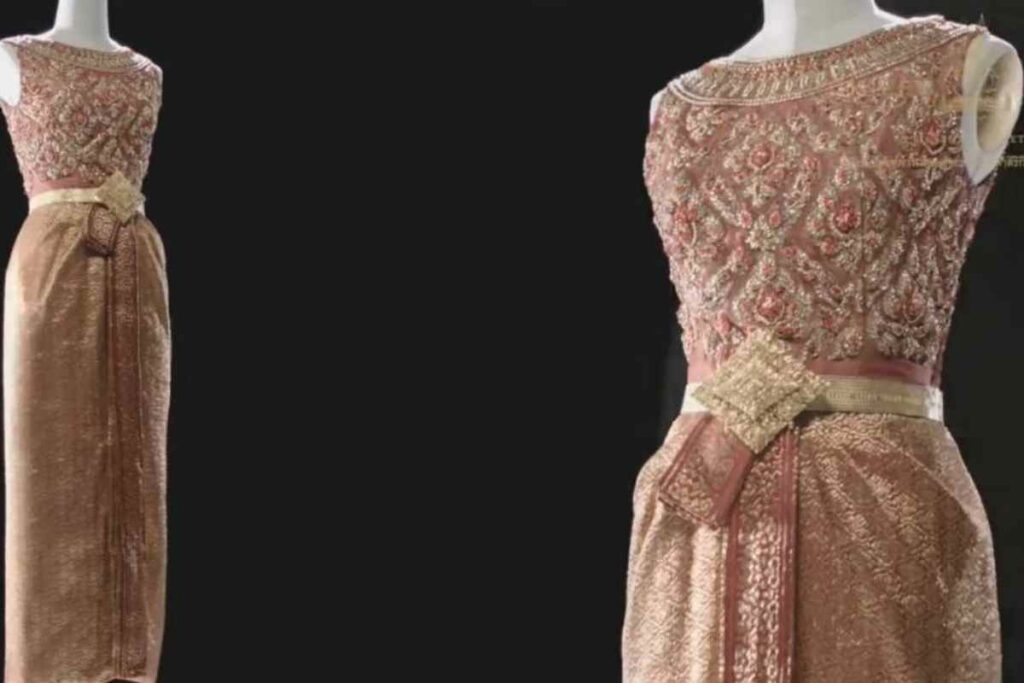
A Dusit is visually the most modern and more Westernized form of a Thai outfit.
Since it is a mix of Thai and Western fashion influences, Dusit is intended to be worn (as what others would usually call) Western-style evening wear.
The outfit features a slim-fitting dress with a round neck and no sleeves. It can be worn as a one-piece dress or as a skirt and blouse outfit.
The dress is usually made of brocaded silk and accessorized with either traditional or Western jewelry. People usually wear this dress style at less-formal evening events or international events due to its conventional look. (Source, Source)
Formal Chut Thai for men
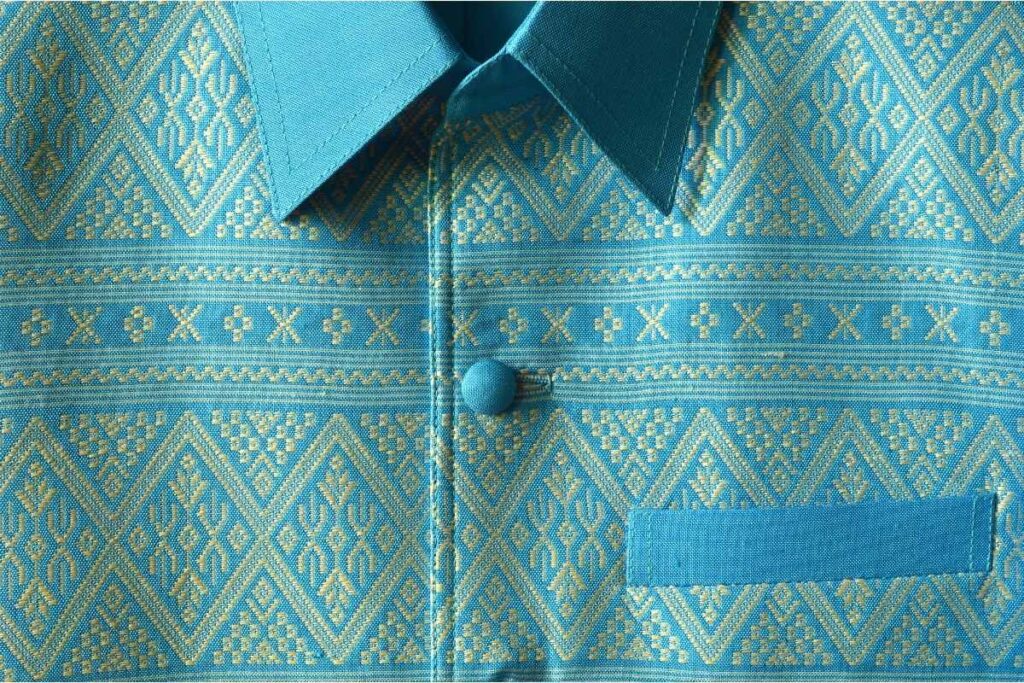
There are many different Thai men’s clothes. However, the one considered to be the formal attire for Thai men is known as Suea Phraratchathan.
Suea Phraratchathan
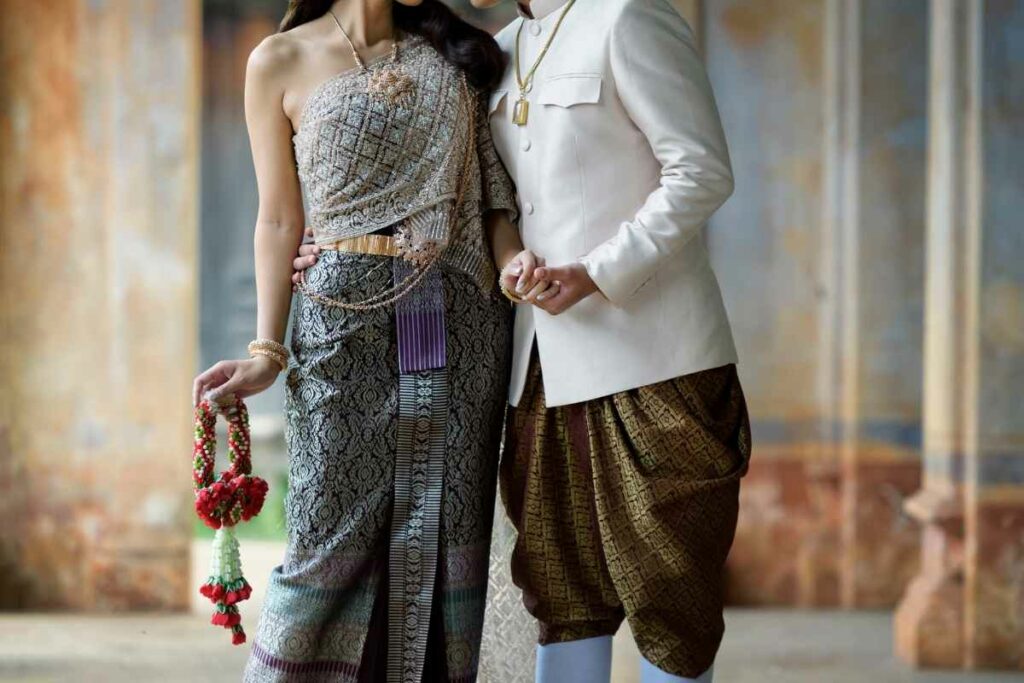
The name “Suea Phraratchathan” literally means “Royal-bestowed shirt” in Thai.
The outfit was first created in 1979 for the King of Thailand and was popularized by General Prem Tinsulanonda, the then Minister of Defense.
The outfit has a resemblance to the Raj-pattern jacket. However, a Suea Phraratchanthan is specified as having a standing Mandarin collar, two outer pockets, and five buttons. The shirt may come in three different versions – short-sleeved, long-sleeved, and long-sleeved with a slash. This depends on the level of formality.
A Suea Phraratchathan is typically worn with Western-style suit trousers, but there are some instances in which it is paired with more “Thai-style” pants. (Source, Source)
Modern-day Thai traditional dresses
Although Chut Thai dresses were created for the Queen’s visit to the U.S. in 1960, these traditional dresses are worn by Thai people today – for all kinds on various occasions.
Thai traditional dresses in beauty pageants
For example, Thailand’s beauty queens are seen wearing Chut Thai-inspired dresses in the National Costume category of international pageants like Miss World and Miss Universe.
In 2017, Miss Thailand, Chalita Suansane, wowed the fans with her national costume, which was inspired by the vintage photos of Queen Sirikit.
The dress was embroidered with a hundred thousand Swarovski crystals and was designed by the culture scholar Hirankrit Pattaraboriboonkul. Also, in the Miss Grand Thailand competition, the national costume round is given a lot of importance. Contestants are seen wearing various forms of Thai traditional costumes designed to represent the region they are from. (Source, Source)
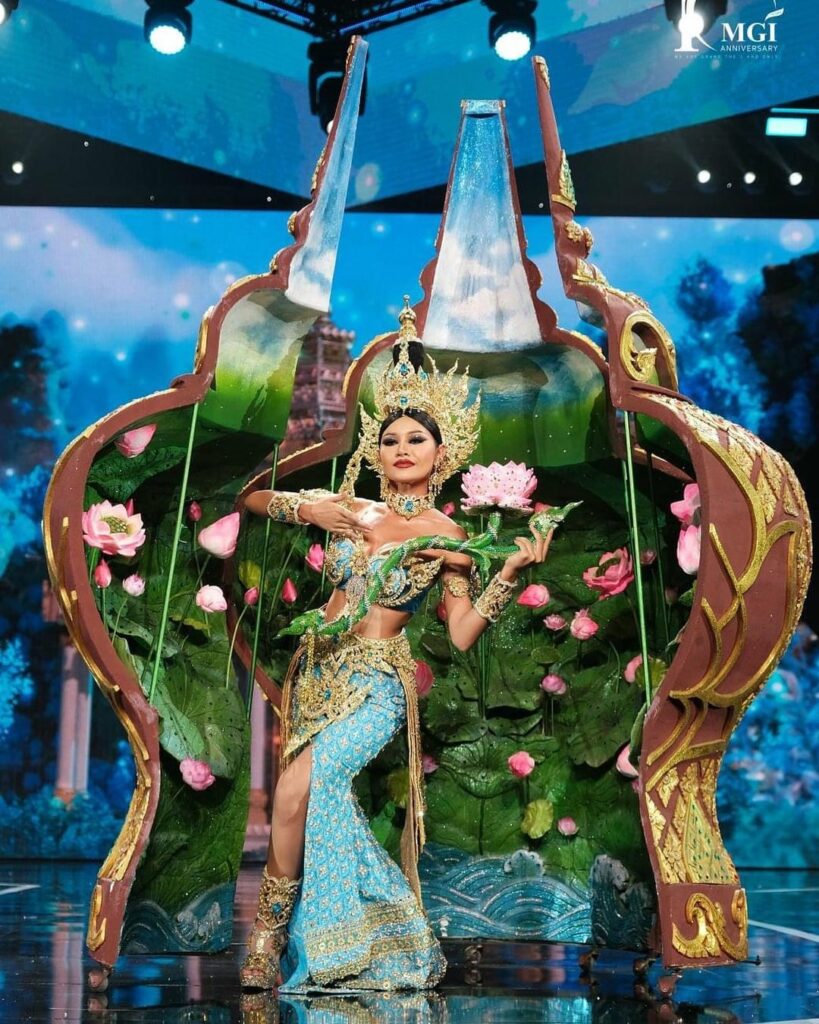
▸ Curious about Thailand’s beauty pageants? Check out our articles: “Miss Thailand” and “Miss Universe Thailand“
Thai traditional dresses for weddings
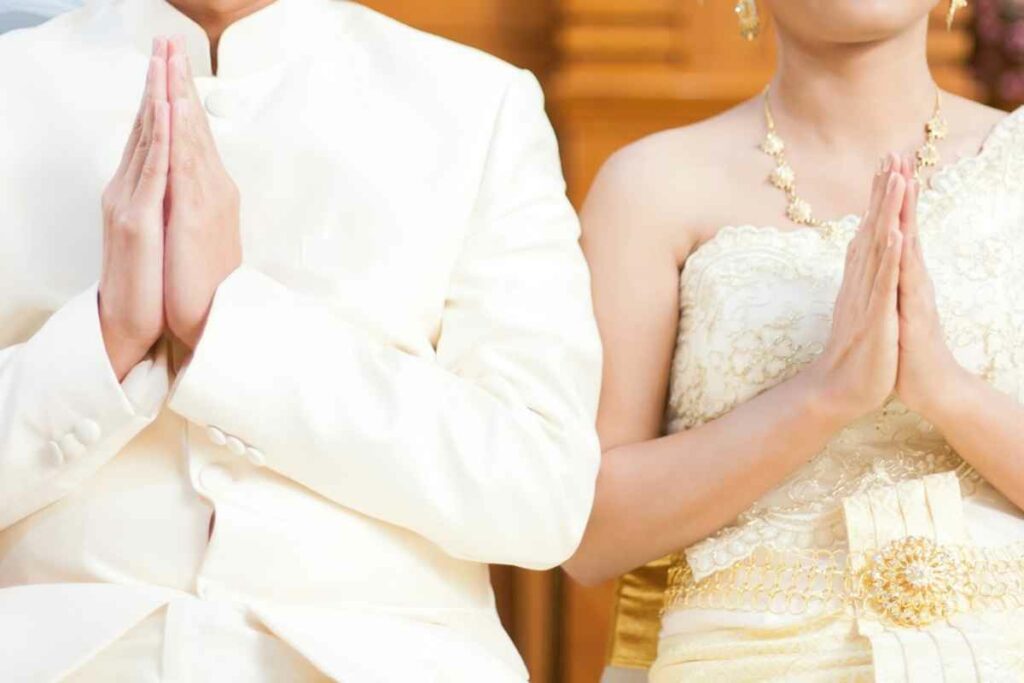
Aside from the beauty pageants, traditional Thai dresses are worn during essential days like weddings or graduation.
Brides:
As there is no “official” traditional Thai wedding dress, Thai brides can choose from the eight designs of Chut Thai costumes. Many Thai brides tend to wear tight-fitting, brightly colored Thai silk costumes on their wedding day.
Sometimes, brides would wear a floor-length, over-the-shoulder shawl to add the extra factor to their outfits. Accessories such as gold jewelry, necklaces, belts, and brooches are often paired with the outfits, too.
Grooms:
As for the grooms, they would usually be seen wearing traditional Suea Phraratchathan outfits. Some may choose to wear their traditional pants with a Western-style suit jacket and tie. Many grooms also opt for a white ensemble for their choice of outfit. (Source)
Thai costume events
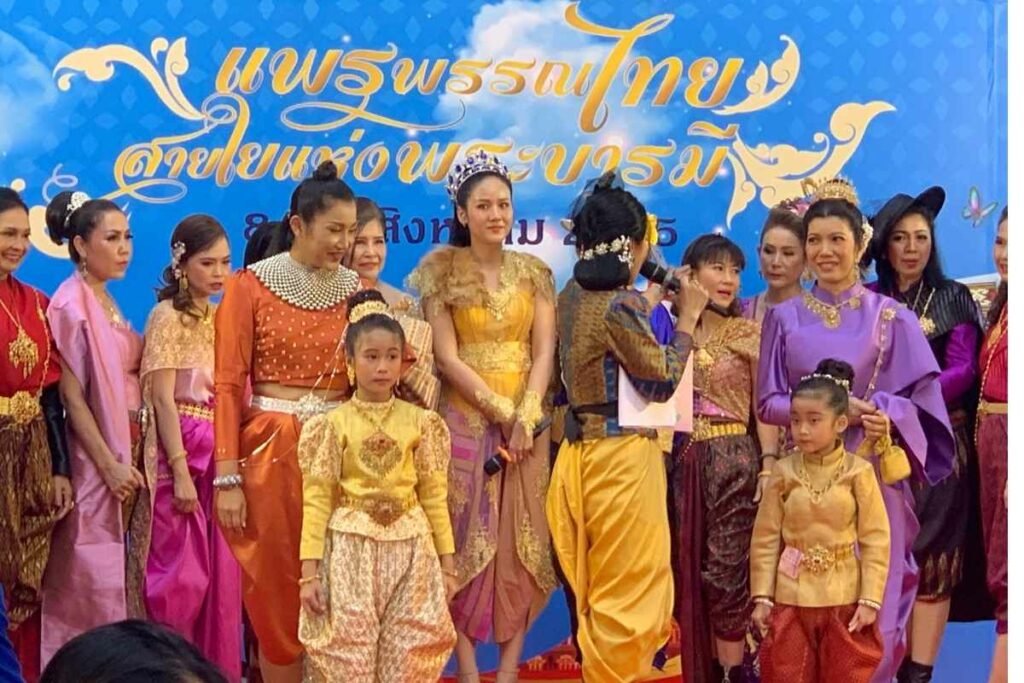
There have been some events organized by both the government and non-government organizations to promote Thai traditional costumes.
In February 2018, the royally-initiated festival Winter Dusit, or the Oon Ai Rak Klay Kwam Nao, received a lot of attention from local people who were eager to dress up in various traditional Thai costumes.
People visiting the festival wore puffed-sleeve blouses, lace, and Jong Kraben-style pants. They lined up near the Royal Plaza, where the festival was held.
This provoked the interest of young Thai people in traditional outfits, as many young people would only usually wear traditional costumes for official functions or important social events. (Source)
The “Lalisa effect”
Last year, there was a surge in interest in Thai traditional dresses and headdresses.
All thanks to the world-renowned Kpop idol, Lisa.
Born and raised in Thailand, Lisa (or Lalisa Manoban) paid tribute to her roots in the music video of her solo debut song “Lalisa.” She did this by wearing a traditional Thai dress-inspired costume and a headdress that is usually worn by traditional Thai dancers.
The song was a huge success. And so was the interest in the Thai costume and accessories Lisa displayed in the music video.
Traders at a famous market in Bangkok said that ever since her famous music video, there has been an increased demand for traditional outfits and accessories.
In an interview with Reuters, Samorn Suthiwong, a worker from a clothes store in the market, said that a lot of people had ordered from their online shop, and there had been a constant flow of customers coming to their physical store to ask what kind of headgear they have, and in what style and color.
Thai designer brand Asava was the one in charge of the custom long, shiny gold cape, crop top, and wrapped mini skirt that was worn in the music video.
According to the Instagram post shared by Polpat Asavaprapha, the Lalisa dress was created exclusively for the idol. It was specifically made with traditional Thai brocade and golden silk, which were delicately woven in metal-treaded ancient traditional Thai clothing patterns from the Lamphun province.
On top of that, the costume was embroidered by hand and embellished with sparkling Swarovski crystals.
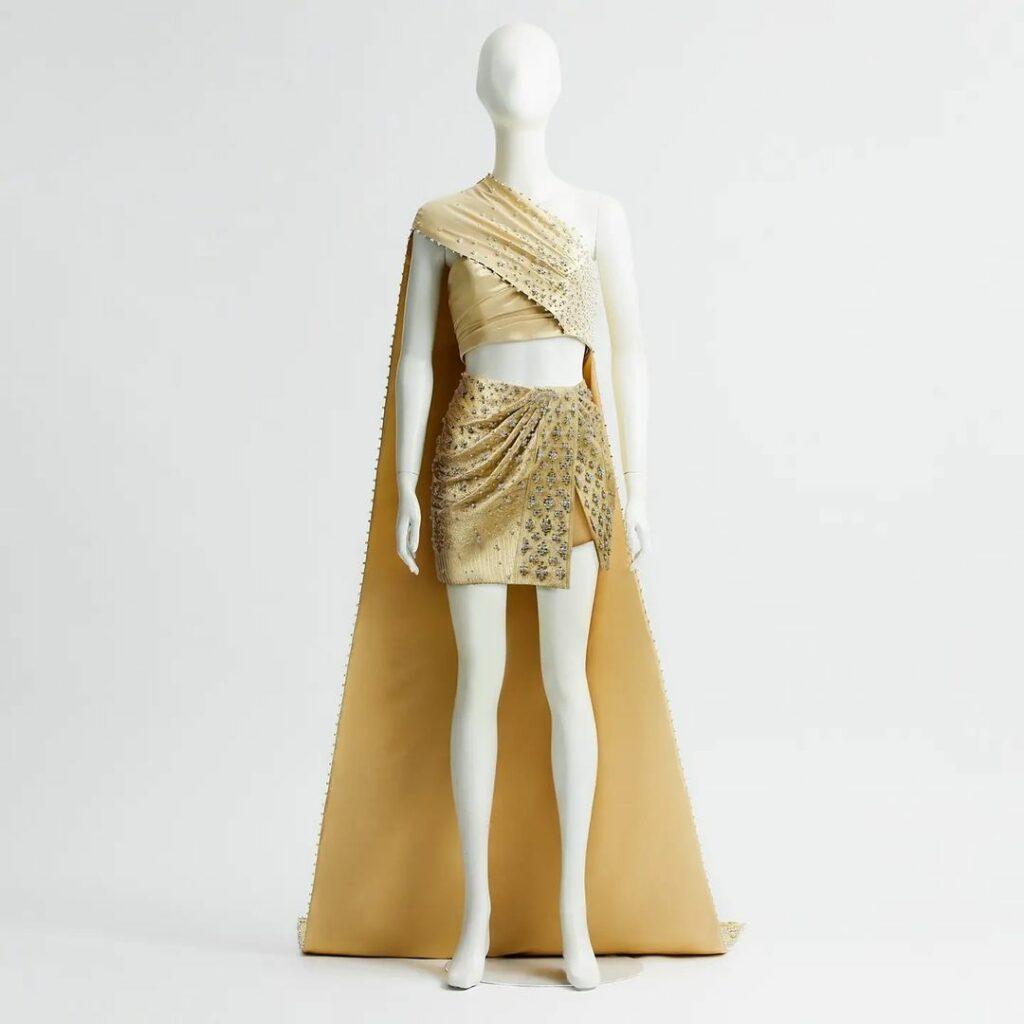
The much-talked headdress was made by the Thai fashion designer Prapakas Angsusingha, from the brand Hook’s by Prapakas. The headdress was inspired by “Rad Klao Yod,” which is an elaborate headdress with flowers attached to it.
Traditional Thai female dancers have usually worn such headdresses during their performances ever since the Ayutthaya era.
Although the exact price of the customized headdress worn by Lisa is unknown, traditional headdresses like this were usually sold in the markets for a price between 250 to 1000 THB (6 to 27 USD) per piece.
And thanks to Lisa’s music video, some shops selling traditional headdresses saw a 10% increase in their income.
Prasop Riengngern, the Deputy Permanent Secretary of the Ministry of Culture, also praised Lisa and the designer Polpat Asavaprapha for promoting Thai culture through fashion, as it helped Thai costumes to gain more recognition on the international stage. (Source, Source)
Where to find Thai traditional outfits?
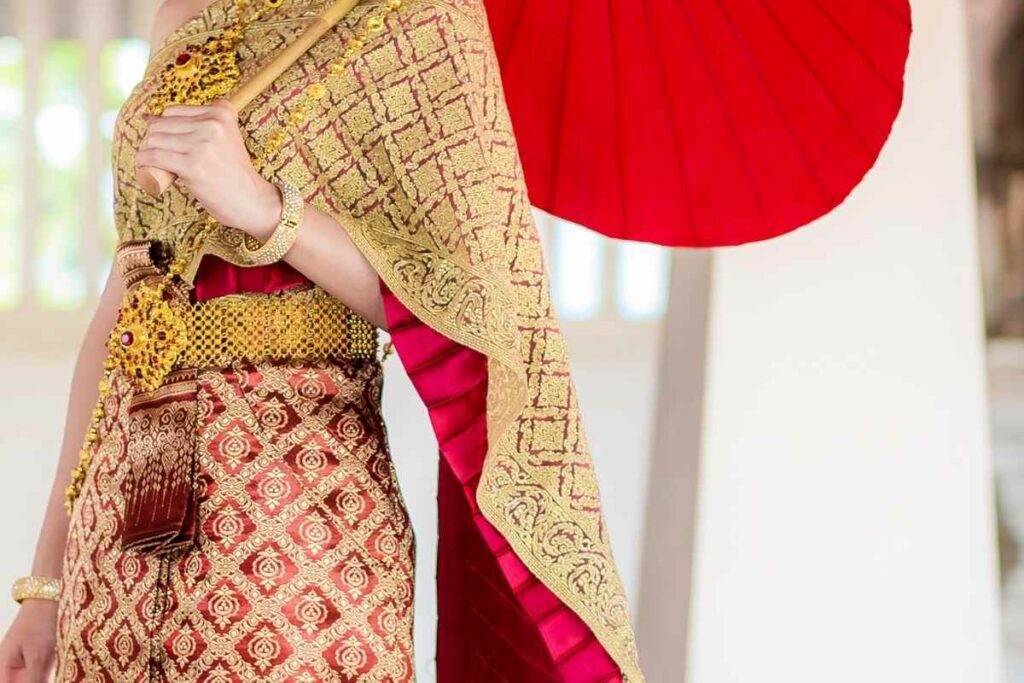
Queen Sirikit Museum of Textiles
Address: Na Phra Lan Rd, Phra Borom Maha Ratchawang, Phra Nakhon, Bangkok 10200, Thailand (inside the Royal Palace compound)
Contact Number : +66 2 225 9430 Opening Hours: 9:00 AM to 4:30 PM
There is no better way to experience and witness various Thai traditional outfits than visiting the Queen Sirikit Museum of Textiles in Bangkok.
The Queen herself is the creator of the Chut Thai dresses, and the museum is named after her to honor the Queen’s efforts to develop traditional dresses. This museum hosts various rooms inside the building, such as a library, a lecture hall, an education studio, and the first laboratory in Thailand dedicated to textile conservation.
It was first opened in 2003, on the grounds of the Royal Palace, which was built by King Rama I in 1870.
The exhibitions inside the museum tell the story of Queen Sirikit and how she developed the traditional outfits and transformed Thai silk into the country’s symbol. The highlight of the museum would be the Queen’s personal collection of dresses. By visiting the museum, you can easily witness all the different Chut Thai dress types in one place. (Source)
Sense Of Thai
Address: Tha Maharaj (~300m from Grand Palace), 1/11 Trok Mahathat, Maharaj Rd, Phrabarommaharajwang, 10200, Bangkok
Contact Number : +66 94 321 5225 Opening Hours: 10:30 AM – 7 PM
If you want to rent a Thai traditional dress to go around the temples and city attractions for a day, here is where you can find one.
There is a traditional Thai costume rental shop called ‘Sense of Thai‘ conveniently located near the popular Thai temples, Grand Palace, Wat Pho, and Wat Arun.
Upon visiting the shop, you can browse various Chut Thai dress collections in various colors, patterns, materials, and designs. The dresses also come in various sizes – from X.S. to 2XL, Thai traditional dresses for girls, and X.S. to 3XL Thai clothing for men.
Then, you can try on up to 2 different costumes to pick the one you like the best or even ask the advice from the store’s stylist to dress you up.
There are also accessories and handbags you can rent to complete the look. And for couples and groups, the shop offers couple outfits and group packages too. So, you can take photos in matching outfits!
Check out the ‘Sense of Thai’ on Instagram to see the beautiful Thai traditional dresses you can rent from them.
The rental cost is 550 THB (15 USD) for a one-day rental service for both outfits and accessories.
There is a private photographer service available at the shop, so for those who want to take beautiful photos in Thai costumes, make sure to request.
For making reservations, you can book via the Line account of the shop.
On the day of the visit, customers can leave their bags and luggage in the shop for a temporary period. Still, it had been advised not to leave any valuable belongings in the bag as the shop will not be responsible for any lost items.
The customer needs to pay a deposit of 1000 THB (27 USD), which will be returned once the dress is returned and confirmed for no damage by the shop’s staff. Unfortunately, there is no costume available for infants. (Source, Source)
Thai Style Studio
Address: 444 MBK Center Phayathai Rd. Pathumwan Bangkok, Thailand, 10400 : 3 floor. Zone C (3C09)
Contact Number : +66 2 048 7136 Opening hours: 10:00 AM – 8:30 PM
If you are looking for an indoor photo studio to take photos with Thai costumes, complete with hair and makeup, then this would be the one for you.
Located on the 3rd floor of the famous MBK shopping center, Thai Style Studio has a long-standing history of Thai costume rental services. They have been operating for over three decades already and provide studio photoshoots with traditional Thai settings to help their customers capture the essence of unique Thai culture.
And of course, customers can rent costumes and also get full premium hair and makeup services completed with a headdress if they wish to go full costume.
The process of renting a Thai traditional customer here is also simple:
First, you will have to book ahead of the day they want to rent the costumes by emailing [email protected] or a message via the Thai Style Studio 1984 account on Facebook and Instagram.
Then on the day itself, customers can choose from an array of Thai cultural, traditional dresses and accessories that the shop has to offer and ask for assistance from the studio’s staff as well.
After selecting the costume, the customer will have to pay a deposit of 1500 THB (40 USD) to rent the outfit for three days. And within three days, the customer can return the rented costume to the studio to get the deposit back.
The cost of renting a standard costume set for three days is 2,000 THB (55 USD), while a fully premium set includes everything – from hair and makeup services to accessories like belts, headdresses, and necklaces, which is 2,300 THB (62 USD).
Or, if you would like to book an outdoor photoshoot, it is possible to do so at Thai Style Studio as well.
The cost for outdoor photoshoot service is 4,000 THB (110 USD) per hour – including costumes, hair and makeup services, and photographer service.
For every additional person, the extra cost will be 2,500 THB (68 USD). However, it is important to know that all the prices for outdoor photoshoots do not include the entrance fees one will have to pay at most tourist attractions places like temples and museums. (Source)
Costume rental shops at Ayutthaya
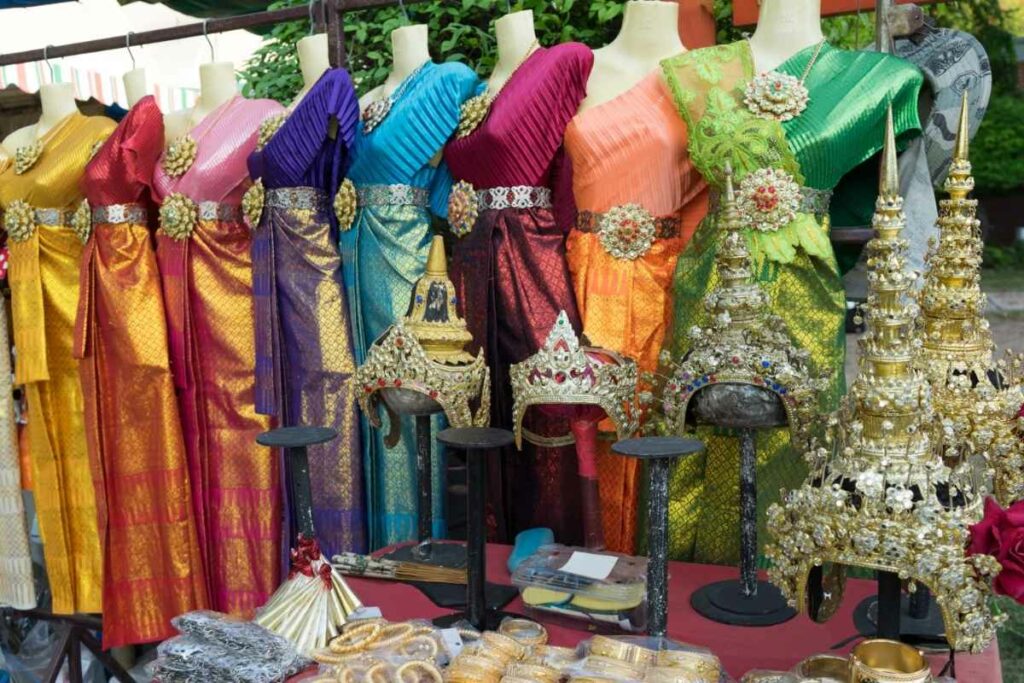
As Ayutthaya is known as the ancient city of Thailand, taking photos at the temples in traditional Thai costumes seems to be a popular trend among both local and foreign visitors.
While taking a day trip to Ayutthaya, you can easily rent a traditional Thai costume from the local rental shops located across the city. Just make sure to look for the small shops near the temple entrance, and you can rent each outfit and umbrella for a price of 500 THB (14 USD) at the majority of the shops.
Although the dresses may not be as new or as well-made as the ones you can rent at the above-mentioned photo studios from Bangkok, it is a convenient and affordable option to take some memorable photos while visiting the famous ancient temples of Ayutthaya.
Places to buy a traditional Thai dress
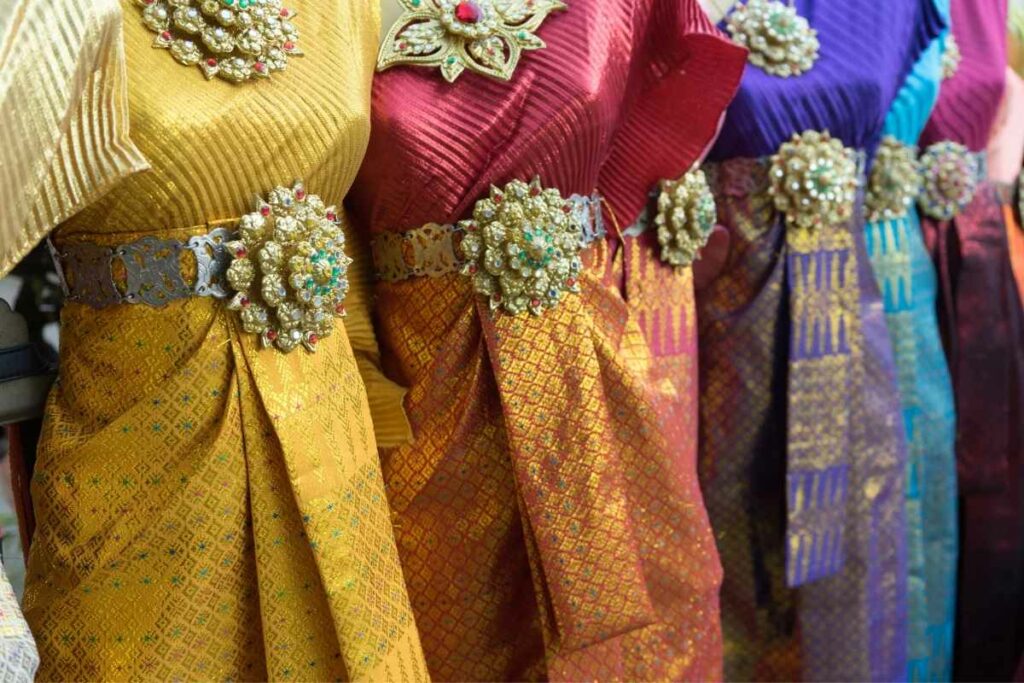
If renting the costume for a few days is not enough for you, there are several shops around the city that sells Thai silk and make dresses on request. Some recommended places to buy a traditional dress are as written below:
Queen Thai Silk
Address: 10/4 Trendy plaza Soi Sukhumvit 13, Khlong Toei Nuea, Watthana, Bangkok 10110, Thailand
The shop uses 100% pure Thai silk to create beautiful traditional Thai dresses in just a couple of days. The customers can choose the fabric and design they want and have the dress tailored-made for them here. However, it has been said that the prices are costly as they use quality silk and would usually charge 1500 to 1800 THB (40 to 50 USD) per yard. (Source)
Narai Phand
Address: Eight Thonglor Building (1st Floor No. 88/333, Sukumvit 55 (Thonglor Klongton Nua Watthana, Bangkok 10110, Thailand
This shop has been operating for more than 72 years and is known to have some of the best handicrafts in Bangkok.
What’s interesting about this shop is that the handicrafts sold here come from regions and villages across the country, and the reason why is to create aid for the villagers who produce these handicrafts.
And besides traditional dresses, one can also find skirts, scarves, shawls, bags, etc.
Chut Thai, Thai culture.
It is truly mesmerizing to see how each Chut Thai traditional dress is designed to be worn on different occasions.
There have also been a lot of influences from different cultures and ancient kingdoms on Thai formal dresses. This makes them unique and diverse compared to traditional outfits from other Southeast Asian countries.
So, if you are looking for a fun yet authentic way to experience Thai culture, perhaps trying on one of these beautiful traditional dresses and taking photos at the landmarks would be a great way to spend your time.
Thai Traditional Dress FAQs
1. How do traditional people dress in Thailand?
People would dress in Chut Thai traditional outfits for formal occasions and royal events in Thailand.
2. What is the traditional clothing for women in Thailand?
There are eight different traditional Chut Thai dresses for women in Thailand, and they are – Chakkri, Chakkraphat, Amarin, Boromphiman, Siwalai, Ruean Ton, Chitlada, and Dusit.
3. What is the traditional clothing for men in Thailand?
The traditional Chut Thai clothing for men in Thailand is known as Suea Phraratchathan.
4. What is Thailand’s national costume?
There is no one national costume in Thailand; however, Chut Thai dresses can be considered the official traditional costume of the country.
5. What does the Chut Thai symbolize?
Chut Thai symbolizes Thailand’s identity as well as the different traditional weaving techniques, local patterns, the inherent modesty of the local people, and the imagery of the country.
6. What is the type of cloth used for traditional Thai clothing?
Silk is the main type of cloth used for traditional Thai clothing. Modern Thai dresses also would use cotton.
7. What is a Pakama Thailand?
A Pakama is a piece of cloth worn around the waist and can also be used as a head covering or towel when needed. This type of clothing is used by males in Thailand.
THINKING ABOUT A TRIP TO THAILAND?
I am working on a FREE Thailand Travel Guide with a FULL 7 Day Itinerary. Be the first to receive it!
Thank you for signing up.
Something went wrong.
